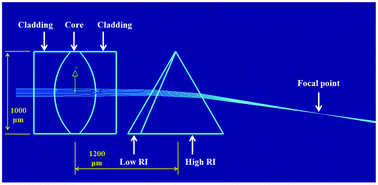An in-plane optofluidic microchip for focal point control
Abstract
A polydimethylsiloxane (PDMS) optofluidic microfluidic chip comprising a tunable optofluidic in-plane biconvex microlens and a tunable optofluidic in-plane microprism is proposed for controlling the focal length and deviation angle of a light beam. In the proposed device, the microlens comprises an expansion chamber containing a high refractive index stream sandwiched between two low refractive index streams. Meanwhile, the microprism comprises a triangular chamber filled with two liquids, one with a higher refractive index than that of PDMS and the other a lower refractive index than that of PDMS. It is shown that the radius of curvature (and therefore the focal length) of the microlens can be adjusted by controlling the flow rate ratio of the core and cladding streams. In addition, it is shown that the deviation angle of the light ray exiting the microprism depends on the refractive indices of the two working fluids, the apex angle of the prism chamber, and the flow rate ratio of the two working fluids. In general, the results show that the biconvex microlens enables the focal length to be adjusted in the range of 2.9–7.6 mm when using


 Please wait while we load your content...
Please wait while we load your content...